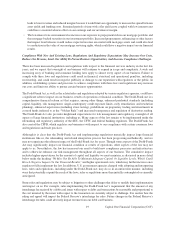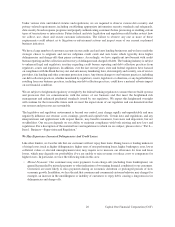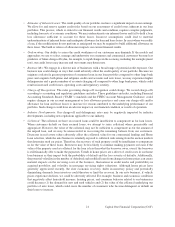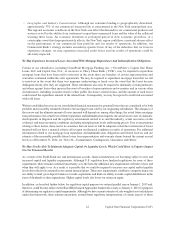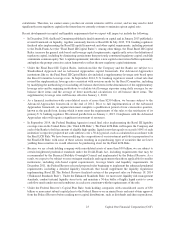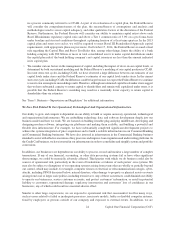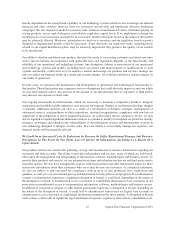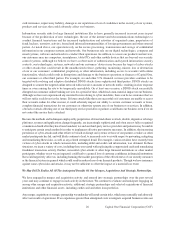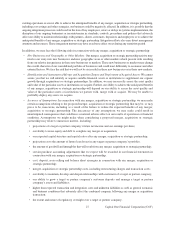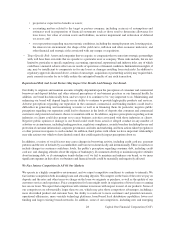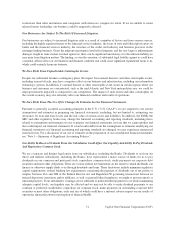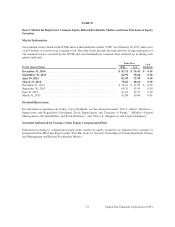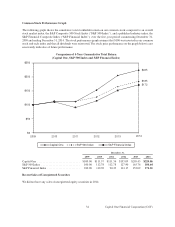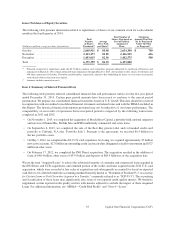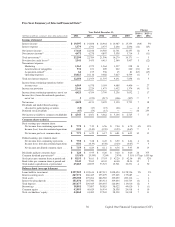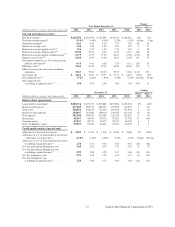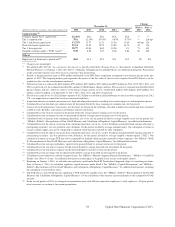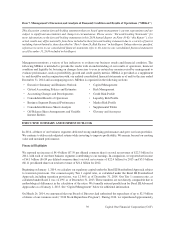Capital One 2014 Annual Report Download - page 51
Download and view the complete annual report
Please find page 51 of the 2014 Capital One annual report below. You can navigate through the pages in the report by either clicking on the pages listed below, or by using the keyword search tool below to find specific information within the annual report.competitors in the digital and mobile payments space, are not subject to the same regulatory requirements or legislative
scrutiny to which we are subject, which also could place us at a competitive disadvantage.
Many of our competitors are focusing on cross-selling their products and developing new products or technologies,
which could affect our ability to maintain or grow existing customer relationships or require us to offer lower interest
rates or fees on our lending products or higher interest rates on deposits. This increasingly competitive environment is
primarily a result of changes in regulation, changes in technology and product delivery systems, as well as the
consolidation of financial service providers, all of which may affect our customers’ expectations and demands.
We operate the largest online direct banking institution in the U.S. by deposits. While direct banking represents a
significant opportunity to attract new customers that value greater and more flexible access to banking services at
reduced costs, it also presents significant risks and we face strong competition in the direct banking market. Aggressive
pricing throughout the industry may adversely affect the retention of existing balances and the cost-efficient acquisition
of new deposit funds and may affect our growth and profitability. In addition, the effects of a competitive environment
may be exacerbated by the flexibility of direct banking and the increasing financial and technological sophistication of
our customer base. Customers could also close their online accounts or reduce balances or deposits in favor of products
and services offered by competitors for other reasons. These shifts, which could be rapid, could result from general
dissatisfaction with our products or services, including concerns over pricing, online security or our reputation.
We have significantly expanded our credit card partnership business over the past several years with the additions
of a number of credit card partnerships. The market for key business partners, especially in the Credit Card
business, is very competitive, and we cannot assure you that we will be able to grow or maintain these partner
relationships. We face the risk that we could lose partner relationships, even after we have invested significant
resources, time and expense into acquiring and developing the relationships. The loss of any of our business
partners could have a negative impact on our results of operations, including lower returns, excess operating
expense and excess funding capacity.
In such a competitive environment, we may lose entire accounts or may lose account balances to competing firms,
or we may find it more costly to maintain our existing customer base. Customer attrition from any or all of our
lending products, together with any lowering of interest rates or fees that we might implement to retain customers,
could reduce our revenues and therefore our earnings. Similarly, unexpected customer attrition from our deposit
products, in addition to an increase in rates or services that we may offer to retain those deposits, may increase our
expenses and therefore reduce our earnings.
If We Do Not Adjust To Rapid Changes In The Financial Services Industry, Our Financial Performance
May Suffer.
Our ability to deliver to stockholders strong financial performance and returns on investment will depend in part on our
ability to expand the scope of available financial services to meet the needs and demands of our customers, including
by marketing new products to our customer base. Our ability to meet our customers’ needs and expectations is key to
our ability to grow revenue and earnings.
We expect digital technologies to have a significant impact on banking over time. Consumers increasingly expect robust
digital experiences from their financial services providers. The ability for customers to access their accounts and conduct
financial transactions using digital technology, including mobile applications, is an increasingly important aspect of
the financial services industry and it impacts our ability to deliver products and services to our customers. To that end,
financial institutions are rapidly introducing new digital and other technology-driven products and services, which aim
to offer a better customer experience and to reduce costs. We continue to invest in digital technology designed to attract
new customers, facilitate the ability of existing customers to conduct financial transactions and enhance the customer
experience related to our products and services. Our continued success depends, in part, upon our ability to address the
needs of our customers by using digital technology to provide products and services that efficiently meet their
expectations in a cost-effective manner. The development and launch of new digital products and services depends in
29 Capital One Financial Corporation (COF)


